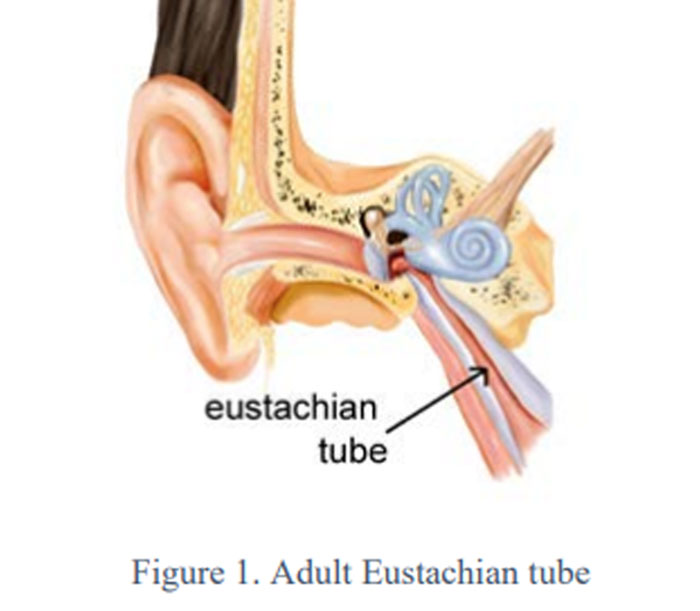Eustachian Tube Dysfunction
What is Eustachian tube dysfunction?
Eustachian tube dysfunction is an affliction that can lead to a chronic ear pressure and pain or discomfort with barometric changes.(1) Typically, when you yawn, chew, sneeze, or swallow, your Eustachian tubes – small passageways that run between your middle ear and upper throat – open to keep pressure and fluid from building up. If you experience a blocked Eustachian tube – also known as Eustachian tube dysfunction – your ears may feel full or painful, and your hearing may seem muffled.(2)
What causes Eustachian tube dysfunction?

If the Eustachian tubes become inflamed – typically due to illness or allergies – mucus or fluid can build up.(3) This improper drainage causes the pressure, fullness, pain, and/or hearing changes that characterize the condition.
What are the causes of Eustachian tube dysfunction?
Colds, flus, sinus infections, or allergies can cause the Eustachian tube in one or both ears to become inflamed, preventing proper mucus drainage and leading to symptoms. Altitude changes can also cause problems with the Eustachian tubes or aggravate existing inflammation. Activities such as hiking, flying on a plane, or even riding an elevator could cause symptoms.(3)
Who is at an increased risk of developing Eustachian tube dysfunction?(3)
People who smoke are at an increased risk because smoking damages cilia – tiny hairs that line the middle ear and help sweep mucus toward the throat. People who are obese are also at a higher risk because fatty deposits can form around the Eustachian tubes, leading to dysfunction.
Allergies can also increase a person’s risk, as they can lead to frequent episodes of mucus production and congestion.
Nasal polyps, a cleft palate, or a tumor may put someone at increased risk of developing Eustachian tube dysfunction.
What are the complications of Eustachian tube dysfunction?(3)
The most common complication is recurring Eustachian tube dysfunction – which is possible if you don’t treat the underlying cause or risk factor. In rare, more severe cases, Eustachian tube dysfunction may also lead to:
- Chronic otitis media, a middle ear infection
- Otitis media with effusion, or “glue ear,” a fluid buildup in the middle ear that can last for weeks and could damage hearing
- Eardrum retraction, when the eardrum is seemingly sucked farther into the ear canal
How long does Eustachian tube dysfunction last?
Most cases of Eustachian tube dysfunction clear up in a few days with the help of over-the-counter medication and home remedies, but symptoms can last one to two weeks. If you’re still having symptoms after two weeks, or they’re getting worse, you may need more aggressive treatment.(3)
What is the typical Eustachian tube dysfunction recovery time?
Most people feel better in a few days to a week or two. If symptoms last longer, get worse, or seem to recur, you should see a doctor.
Facts about Eustachian tube dysfunction
- Eustachian tube dysfunction affects 7.3 million people in the United States.(4)
- There is no increased risk for developing Eustachian tube dysfunction based on gender or ethnicity.(3)
- The incidence of Eustachian tube dysfunction is disproportionately high in patients with cleft palate – some reports say as high as 79 percent.(5)
Eustachian tube dysfunction symptoms
A buildup of mucus in the middle ear causes symptoms. Symptoms are often mild and limited to a few days following a cold or flu. If symptoms last more than two weeks, recur frequently, or are severe, it’s a good idea to schedule an appointment with your doctor.
Symptoms of Eustachian tube dysfunction often include

How does a doctor test for Eustachian tube dysfunction?(1)
Your doctor will ask about your symptoms, examine your ear canals and ear drums, and check your nasal passages and the back of your throat for signs of inflammation and mucus buildup. Symptoms, and a recent history of cold, flu, or allergies is often enough to diagnose Eustachian tube dysfunction.
If symptoms linger, recur, or get worse, your doctor may want to check for underlying problems or other conditions that could be leading to your pain, fullness, and hearing changes. Tests may include:
- Valsalva Maneuver
- Audiogram
- Tympanogram
- Otoscopy/ Nasopharyngoscopy
- CT Scan
Valsalva Maneuver
Pinching the nose and closing the mouth and trying to breathe out through the nose can sometimes help clear the ears if your symptoms stem from air pressure changes.

Based on the findings of the assessments above – or if symptoms persist for more than three months and medical management fails – your doctor may recommend Eustachian tube dilation.
Eustachian tube dysfunction treatment
Eustachian tube dysfunction usually resolves in a few days to two weeks without treatment. You can take certain actions to open up the tubes, such as swallowing, yawning, or chewing gum. And, you can try the Valsalva maneuver at home by taking a deep breath, pinching your nostrils closed, and blowing with your mouth shut. Babies and toddlers with Eustachian tube dysfunction may benefit from frequent feeding or sucking on a pacifier.
If these strategies don’t help, your doctor may suggest options for medical management.
Medical treatments for Eustachian tube dysfunction
Your doctor may first recommend over-the-counter treatments, such as:
- Decongestants to reduce the swelling of the lining of the tubes
- Antihistamines and/or steroid nasal spray to reduce an allergic response
If a bacterial infection is present, your doctor may prescribe an antibiotic.
Some people with more severe or chronic symptoms may need to undergo a surgical procedure. These include:(6)
- Fluid Removal: After making a tiny incision in the eardrum, your doctor can suction out fluid from the middle ear, giving the Eustachian tube lining time to shrink while the eardrum is healing.
- Ear Tubes: Implantation of small tubes in the eardrums allows built-up fluid to drain out of the middle ear. This procedure is commonly performed on young children who get frequent ear infections. The tubes stay in for up to 18 months and fall out on their own.
What is Eustachian tube balloon dilation?
Many of the current treatment options for Eustachian tube dysfunction are limited or invasive, but a newer treatment option using balloon dilation can restore Eustachian tube function and relieve symptoms.7 The XprESS™ ENT Dilation System provides a safe, effective, and less invasive treatment for people with Eustachian tube dysfunction.
During this procedure, your doctor will insert a small balloon through your nose and into your Eustachian tube. The balloon will then be gently inflated, and after treatment, removed. The procedure is performed under local anesthesia.
